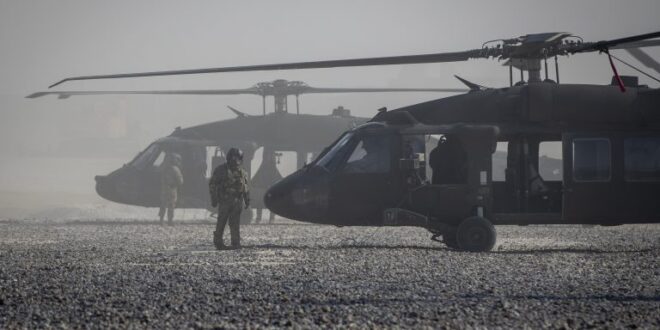Iran’s drone strike on the U.S. base at Al Tanf, in Syria last week, reflects Iran’s increasing willingness to take direct military action against its adversaries.
After U.S. actions in Afghanistan, Iran perceives that military pressure might compel the United States to withdraw entirely from Syria as well as from Iraq.
The U.S. base at Al Tanf puts U.S. forces in position to monitor and block Iranian weapons shipments to Lebanese Hezbollah.
The strike comes at a time when talks with the United States and major powers to restore the 2015 multilateral Iran nuclear deal are faltering.
In late October, according to the United States Defense Department, a “complex, coordinated, and deliberate attack” was conducted against a U.S. base at Al Tanf in eastern Syria. U.S. officials did not directly blame Iran for the attack, carried out by several armed drones, but Iranian and pro-Iranian media in the region reported that the strike was conducted by Iran. There were no U.S. casualties among the small U.S. contingent at the base, but several of the structures on the base were destroyed. American troops are deployed in Syria under the mission to combat Islamic State, and neither their rules of engagement nor any authorization from Congress calls on them to combat Iran, except in self-defense.
The strike appears to represent the most direct and aggressive action to date undertaken by Iran or its proxies against the roughly 900 U.S. forces still in Syria and raises questions about the timing of such a bold and seemingly risky strike. It can be argued that the U.S. withdrawal from Afghanistan in August has led Iranian leaders to assess that direct U.S. military pressure can compel the United States to withdraw from the region completely. Iranian strategists appeared to draw conclusions from the U.S. withdrawal from Afghanistan in August. The United States justified the withdrawal, in the absence of a political settlement, by citing Taliban threats to resume attacks on U.S. forces if they remained beyond the agreed deadline of May 1. Iran’s allies in Iraq have already engineered the passage of non-binding legislation in Iraq’s parliament calling for a U.S. withdrawal of its 2,500 troops from Iraq, and the United States and Iraq have agreed that U.S. combat forces will depart by the end of 2021. Iran’s leaders apparently see military pressure on U.S. forces as a means to ensure that the deadline is met in Iraq, as well.
In Syria, the deployment of U.S. forces has been an obstruction to Iran’s plan to establish a safe land corridor from Tehran through to the Mediterranean, by which Iran can resupply its main regional ally, Lebanese Hezbollah. Iran’s sea route to the Mediterranean is considered vulnerable to Israeli attacks, and Iran’s current main resupply route via Damascus airport might not be completely secure either given the simmering opposition to President Bashar Al Assad, as well as the presence of U.S. forces in the country. The withdrawal of U.S. forces from Syria, and the securing of a safe land corridor therein, would therefore produce direct and material strategic benefits for Tehran. More generally, a U.S. withdrawal from Syria would continue the process of fully restoring the Assad regime to the writ it had over the entire country prior to the 2011 uprising. It would also further bolster the prospect of countries normalizing relations with Assad, despite presiding over a brutal conflict that killed over 350,000 of his own people over the past decade. Iranian advisors and Iran-recruited militias were pivotal to Assad’s ability to defeat the armed challenge to his regime, and Iran has a stake in his continuation of power.
This recent drone strike raises broader questions for Iran’s relations with major powers and its place in the region. The attack illustrates increasing confidence on the part of Iranian leaders to use military force in the region—a confidence borne, in part, on its highly successful missile strike on Saudi oil facilities in 2019. Iran’s military prowess enables Tehran to demonstrate the ineffectiveness of U.S. sanctions in limiting Iran’s strategic capabilities. In 2018, President Trump exited the 2015 multilateral Iran nuclear deal and reimposed all U.S. sanctions seeking, at least in part, to hinder Iranian military capabilities and roll back its regional influence.
Asserting that the Trump policy shift only emboldened rather than weakened Iran, the Biden administration has re-engaged with Tehran in an effort to restore full American and Iranian compliance with the nuclear deal and presumably calm regional tensions. President Biden has declared that the U.S. would not withdraw from such an agreement so long as Iran remains compliant. Still, six rounds of talks in Vienna since April 2021 did not produce agreement before the election and inauguration in August of Iran’s new President, Ibrahim Raisi. His government has not yet resumed the talks, although it has expressed a willingness to do so, and it has not clarified its negotiating positions in the event talks resume. Iran’s use of military action against U.S. forces in Syria raises questions about whether Tehran perceives that it needs to make the compromises necessary to restore the nuclear deal. The strike at Al Tanf leaves the international community with no clear picture of whether Iran’s interests in the region can be reconciled with the requirements of the U.S. and its allies for regional peace and security.
 Eurasia Press & News
Eurasia Press & News



